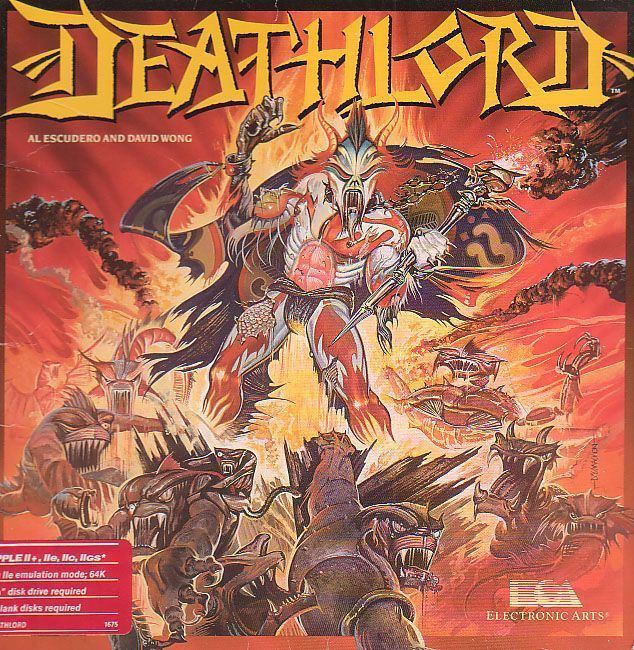Release date(s) 1987 Genre Role-playing video game | Initial release date 1987 | |
 | ||
Similar Legacy of the Ancients, Adventure Construction Set, Questron, Autoduel, Archon II: Adept | ||
Hearthstone the deathlord game
Deathlord is a 1987 role-playing video game created by Al Escudero and David Wong. It was published by Electronic Arts for the Apple II and Commodore 64 computer systems. The game set itself apart by its Japanese flavor, immense game world and length of play.
Contents
- Hearthstone the deathlord game
- Hearthstone best of deathlord
- Story
- Original story design
- Game Play
- Utilities and Initial Setup
- Utilities
- Character Options
- Physical Contents
- Game credits
- Reception
- References
Deathlord has a world of 16 continents, 128 unique monsters, and twenty dungeons, yet fits on only 2 double-density 5¼" floppy disks as it compresses blocks of identical squares on a map.
There is only one savegame slot, and the game frequently autosaves, by design, if the party moves to another location, or a party member dies. A party, once killed, needs a new party to resurrect them.
Hearthstone best of deathlord
Story
The world of Lorn is under attack from the Deathlord's forces. The Emperor of Kodan has sent word asking for a party to defeat the Deathlord. The party must search the world to find seven words, six items, venture into Hell, defeat the Deathlord, and return. There is no linear path to the goals, and much of the story lies in subtext as the developer chose to keep dialog options to a minimum within the game.
Original story design
The Japanese setting and theme of Deathlord was not its original design. Originally, the game was intended to have a Norse/Teutonic theme, But marketing department at Electronic Arts gave Al Escudero 5 weeks to change the assets (art, story, spell names, equipment names, location names, etc.)
Game Play
The game plays as a turn based, top down, tile mapped CRPG. The player would create a party of up to 6 characters to move about the world, searching for secrets and fighting monsters. It used most of the keys on the keyboard, mapping them to specific actions.
Utilities and Initial Setup
Before the player could start the game, they needed to do some tasks first. The game begins by toggling between a title screen and the EA logo in use in 1987. From there a player can press any key to which three options appear at the bottom of the screen, "Utilities," "Character Options," and "Play a Game."
Utilities
Before the player could begin the game proper, they were asked to go to the utility menu and make a copy of the scenario disk. They could also import characters from other games here if they desired.
Character Options
Once scenario disks were made, the player then created their party of 6 characters from the 8 races and 16 classes available. They weren't limited to just 6 characters, however, and could keep a roster of other characters to switch out in the future, but any time they did, the party would be returned to the starting point of the game.
Physical Contents
Deathlord came in an album style box and included two double sided disks, The first containing a side for booting the game, and a side containing utilities while the other disk was the scenario disk containing the unaltered version of the game world. The box also included a paper manual and quick reference card.
The utility disk would let you import characters from Bard's Tale, Wizardry and Ultima III, as well as rename characters and copy the scenario disk. As was common practice for CRPGS at the time, copies of the scenario disk were needed to play as the originals were meant to be an unaltered copy of the game world, and were write protected to stay that way.
The scenario disk(s) contained the game's maps, creatures and conversations as well as the player's character data.
The manual included some initial story elements to help the player understand where the quest began as well as the standard RPG details for character classes, races and magic.
Game credits
Reception
Computer Gaming World in 1988 described Deathlord as "A mediocre effort at best." Criticisms of the game included poor documentation, poor class balance, and meaningless character alignment. The game hid the townspeople with important pieces of information, making mapping necessary, and frequently the player had to search many squares in an area for an important item. One dungeon, described as "one of the most idiotic dungeons ever", featured a two-level maze of locked and fake doors, with a diagonal passage full of teleports and fake walls above. Without a lack of mapping aids, this was very difficult, especially in sixteen-level dungeons that did not contribute to the story. The game's setting was described as "a compendium of standard CRPG features glossed over with a tinge of pseudo-Orientalism by pasting Japanese names on as much as they could." In 1993 the magazine called the game "poorly designed and implemented mishmash with a quasi-Ultima look", "extremeley pointless", and "definitely one to avoid".
Compute! discussed the game's high difficulty and poor quality of the manual. The magazine stated that Deathlord was not the most impressive game, but was a good one.
Home of the Underdogs's Sarinee Achavanuntakul calls Deathlord "One of the best, largest, and most underrated RPGs ever made" and goes on to say it, "offers a unique gameworld inspired by Japanese myths, plenty of traditional exploration-based fun, and the largest map ever made for an Apple II and Commodore 64 game."
Richard Garriott of Origin Systems believed that Deathlord unduly resembled Origin's Ultima games. He ended Origin's affiliation with EA after the company published it, and later Ultima games included a pirate character named Pirt Snikwah.
